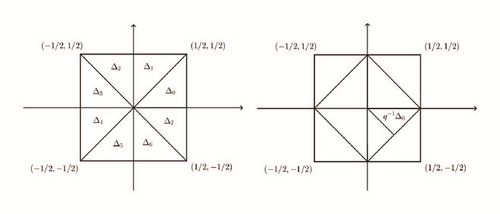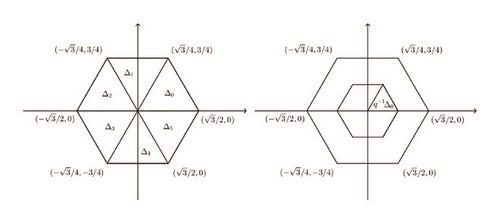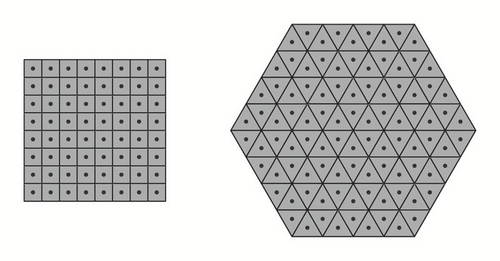Multiresolution Analysis Applied to the Monge-Kantorovich Problem
Abstract
We give a scheme of approximation of the MK problem based on the symmetries of the underlying spaces. We take a Haar type MRA constructed according to the geometry of our spaces. Thus, applying the Haar type MRA based on symmetries to the MK problem, we obtain a sequence of transportation problem that approximates the original MK problem for each of MRA. Moreover, the optimal solutions of each level solution converge in the weak sense to the optimal solution of original problem.
1. Introduction
The optimal transport problem was first formulated by Monge in 1781 and concerned finding the optimal way in the sense of minimal transportation cost of moving a pile of soil from one site to another. This problem was given a modern formulation in the work of Kantorovich in 1942 and so is now known as the Monge-Kantorovich problem.
On the other hand, a big advantage over schemes of approximation was given in the seminal article [1]; it introduced approximation schemes for infinite linear program; in particular, it showed that under suitable assumptions the program’s optimum value can be finite-dimensional linear programs and that, in addition, every accumulation point of a sequence of optimal solutions for the approximating programs is an optimal solution for the original problem. An example given in this article is the Monge-Kantorovich mass transfer (MK) problem on the space itself, where the underlying space is compact.
In [2], a general method of approximation for the MK problem is given, where X and Y are Polish spaces; however, this method is noneasier implementation. Later, in [3], a scheme of approximation of MK problem is provided, which consists in giving a sequence of finite transportation problems underlying original MK problem (the space is compact); nevertheless, a general procedure is given, but the examples are in a two-dimensional cube and use the dyadic partition of the cube for approximation. Our objective is to give other families to approximate this kind of problems, based on Haar type multiresolution analysis (MRA). The advantage of using this technique is that we select a multiresolution analysis that is constructed according to the symmetries of the underlying space. Therefore, the new schemes of approximation take a lot of characteristics of the space into consideration. Note that the dyadic partition of the cube is a particular case of the MRA type Haar using translations and dilations of the underlying space.
The MRA is an important method to approximate functions in different context (signal processing, differential equations, etc.). In particular, we focus on Haar type MRA on ; the constructions of this kind of MRA are associated with the symmetries of the spaces; thus the approximations are related to the geometrical properties of the space. In this construction, the symmetries that we use are general dilations, rotations, reflections, translations, and so forth; for more details, see [4–6].
The main objective of this paper is giving a scheme of approximation of the MK problem based on the symmetries of the underlying spaces. We take a Haar type MRA constructed according to the geometry of our spaces. Thus, applying the Haar type MRA based on symmetries to the MK problem, we obtain a sequence of transportation problems that approximate the original MK problem for each level of MRA. Moreover, the optimal solutions of each level solution converge in the weak sense to the optimal solution of original problem.
This paper is organized as follows. In Section 2, we introduce the basic elements of the Haar type multiresolution analysis and we give some examples of this kind of MRA. In Section 3, we present the approximation of probability measures using Haar type MRA. In Section 5, we apply the Haar type multiresolution analysis to MK problem for each level of this MRA; thus for each level, this new problem is equivalent to transport problem. Moreover, we prove that the optimal solution of MK problems is equal to the limit of the optimal solutions of underlying transportation problems when the level of the MRA goes to infinity. Finally, we give an illustrative example of this method.
2. Haar Type Multiresolution Analysis
We introduce the basic concepts of Haar type multiresolution analysis, following Gröchenig and Madych in [4] and Guo et al. in [5]. Similar results have been obtained independently by Krishtal et al. to be published in [6].
- (i)
Vk ⊂ Vk+1.
- (ii)
.
- (iii)
.
- (iv)
.
- (v)
There exists φ ∈ V0 such that {Tγφ}, γ ∈ Γ, is an orthonormal basis for V0.
-
v′ ) There exists φ ∈ V0 such that {DbTγφ}, b ∈ B and γ ∈ Γ, is an orthonormal basis for V0.
In consequence, we have the following concept.
Definition 1. Let be dilatation set, let B be a finite subgroup of with |det b | = 1, and let Γ be a complete lattice such that Γ = B(Γ). The multiresolution analysis associated with the dilation set A and the group B or AB-MRA is a collection of closed subspaces of , which satisfies conditions (i), (ii), (iii), (iv), and (v′).
- (1)
We take a matrix and the group B = {bi}, 0 ≤ i ≤ 7, of symmetries of unit square; thus,
(7) -
and bi = −bi−4 for 4 ≤ i ≤ 7. Let Δ0 be the triangular region with vertices in (0,0), (1/2,0), and (1/2,1/2); we denote Δi = biΔ0 for 1 ≤ i ≤ 7. If , then the system
(8) -
is an orthogonal basis for its closed span V0. The space V0 is the subspace of , consisting of all square integrable functions that are constant on each -translate of the triangles Δi, 1 ≤ i ≤ 7. Thus, the spaces , , consist of all functions in , which are constant in each -translate of the triangles q−1Δi, 1 ≤ i ≤ 7, in consequence Vj ⊂ Vj+1. Hence, {Vj} is an AB-MRA with φ as a scaling function.
-
Figure 1 is reproduced from Krishtal et al. (2007) [under the Creative Commons Attribution License/public domain].
- (2)
Let B be the group generated by the matrix . This group has order of 6 and is the counter-clockwise rotation by π/3 radians. Consider the hexagon with vertices in set
(9) -
Let Δ0 be the triangle with vertices in (0,0), , and . We define Δi = ρiΔ0 for 0 ≤ i ≤ 5. We take and we define . The set of all functions that are constant on Γ-translates of triangles Δi, 0 ≤ i ≤ 5, is the space . Moreover, the elements of Γ translate the center of the hexagon to the point of Γ, and so we have a partition of . Let and the function , with . The MRA {Vj} is obtained by the system
(10) -
where the spaces Vj are q−j-dilatation of V0, for .


3. Approximation of Measures Using Multiresolution Analysis
3.1. Absolutely Continuous Measures with respect to Lebesgue Measures
- (A1)
X is a compact subset of .
- (A2)
The measure μ is absolutely continuous with respect to λ, where λ is the Lebesgue measure.
Condition (A2) guarantees the existence of functions , where f is the Radon-Nikodym derivative with respect to Lebesgue measure λ.
- (A3)
The functions f also belong in .
Let {Vj} be an AB-MRA on ; the elements of {Vj} are given by scaling functions φ = E1χΔ, the latice Γ, finite group B1, and dilatation .
Remark 2. Note that the classical multiresolution analysis of Haar on is a particular case of AB-MRA on , where the complete lattice is , the group B is trivial, and the dilation associated is A = {2−j(1,1)}. In this case, we have that scaling function is φΔ, where Δ = [0,1]×[0,1] is the fundamental domain associated with the action of Γ on .
From now on, we shall only functions with support in the compact set X and we have ; that is, each function can be considered in , where f(x) = 0 if x ∉ X.
Definition 3. The expectation with respect to Lebesgue measure λ of function f is defined by
In particular, the expectation on the Lebesgue measure λ satisfies the following property.
Theorem 4. Consider that is fixed and . Then , where Pj is the projection of the level j associated with AB-MRA {Vj}.
Proof. We take ; now we calculate ; thus
Using the above equations, we have that
As immediate consequence of the previous theorem, we get the following result.
Corollary 5. We suppose that the measure μ on X satisfies (A1)-(A2); then the sequences of probability measures {μj} ⊂ M+(X) given by (15) converge to μ in and sense.
3.2. Non-Absolutely-Continuous Measures with respect to Lebesgue Measure
Definition 6. Let {μn; n ≥ 0} be a sequence of probability measures on a metric space (X, d). We say that μn converges weakly to μ and denote μn→w μ if μn(f) → μ(f) as n → ∞ for all bounded continuous functions f on M, where μ(f) = ∫M f dμ.
Theorem 7. Given a measure μ on the compact set X, the sequence of measures {μj} on X defined in (21) converge weakly to measure μ.
Proof. Let be a continuous and bounded real function. From the fact that X is compact, we obtain that f is absolutely continuous function on X; thus, given ϵ > 0, there exists δ > 0 such that
In consequence, we obtain the following relations:
4. Discretization of the Monge-Kantorovich Problem Using Multiresolution Analysis
It is said that the MK problem is solvable if there is a feasible solution μ∗ that attains the optimal value. In this case, μ∗ is called an optimal solution for the MK problem and the value inf(MK) is written as min(MK) = 〈μ∗, c〉.
Note that since ν1 and ν2 are probability measures, a feasible solution for MK is also a probability measure. Moreover, if c is a continuous function on X × Y and X and Y are compact subsets on , then the product measure μ≔ν1 × ν2 is a feasible solution. Therefore the MK problem is consistent, and so the MK problem is solvable in this case.
We assume the following conditions: X and Y are compact subsets of and is a bounded continuous function.
Let {Vj} and be AB-MRA on with scaling functions and , lattices Γ1 and Γ2, finite groups B1 and B2, and dilatations and , respectively. We can obtain a new AB-MRA on with scaling functions , lattice Γ = Γ1 × Γ2, finite group B = B1 × B2, and dilatation . The projections of these AB-MRA to the level j are denoted by , , and Qj.
The problem MKDj, given the above system, has a feasible solution, so we know that c is bounded. Then we have that the problem MKDj has an optimal solution; for more details, see Chapter 10 in [7].
Let μ∗ be the optimal solution of MK problem given in (28). We use the optimal solution μ∗ to induce a sequence of measures such that (see Section 3.2). Let be the optimal solution of MKj problem given in (30).
Definition 8. Let be a sub-σ-algebra of , and let be a random variable. We say that the random variable X′ is the conditional expectation of X with respect to and denote it by if and only if
- (i)
.
- (ii)
X′ is -measurable.
- (iii)
, for all .
Remark 9. Given , we have that
Proposition 10. Let μ be a feasible solution of the MK problem; then μj is a feasible solution of the MKDj-problem.
Proof. We suppose that μ satisfies (28). Then we have the following relations:
Remark 11. If μ∗ is an optimal solution of the MK problem, then is a feasible solution of the MKDj-problem.
Proposition 12. Given and , one has
Proof. Let be a generator element of σ-algebra . Then
Definition 13. Let (X, τ) be a topological space, and let be σ-algebra on X that contains the topology τ. Let be a collection of measures defined on . The collection is called tight if, for any ϵ > 0, there is a compact subset Kϵ of X such that, for all measures , |μ | (X∖Kϵ) < ϵ, where |μ| is the total variation measure of μ.
Proposition 14. Consider the sequence of probability measures, where is the optimal solution of MKj for each . Then there exists a subsequent and a probability measure η∗ such that weakly. Moreover, the probability measure η∗ is an optimal solution of MK.
Proof. We know that X1 and X2 are compact sets, provided that the measures are tight for each . Now, using Prokhorov’s Theorem (for details, see Chapter 1 in [8]), there exists a subsequence of and a probability measure η∗ such that weakly.
Notice that is an optimal solution of ; thus, we obtain
Now, we consider μ∗ as the optimal solution of MK. from Proposition 10, we have that is feasible solution of MKj. It follows that
On the other hand, η∗ is a feasible solution of MK; then
5. An Illustrative Example of This Method
- (1)
, where the fundamental region is Δ1 = [0,1/2]×[0,1/2] and the scaling function φ1 = 2χ[0,1/2]×[0,1/2], the lattice is , the finite group B1 is the trivial group, and the dilation A1 = {2−j(1,1)}.
- (2)
, where the scaling function , with Δ2 being the triangle with vertices in (0,0), , and and ; the lattice is , where ; the finite group B2 is the rotation group of a regular hexagon with vertices in the unit circle; the scaling is given by A2 = {aj}, where .
We denote by and the squares and the triangles associated with level j of the multiresolution analysis presented above. Since c is a continuous function in each pair of sets , we have that is approximated to , where and are the centroids of and , respectively.
In particular, we present a discretization of MK problem given by (51) for the level j = 2; the graphical description of the process of discretization is given in Figure 3 (which was generated using Mathematica 11.1.0).

Using and in C and H, respectively, notice that C is the union of congruent squares with disjoined interiors. Similarly, the hexagon H is the union by congruent equilateral triangles , with disjoined interiors. Note that and .
| Level | Solution |
|---|---|
| MK1 | 4.037306413676646 |
| MK2 | 4.029959684992724 |
| MK3 | 4.026748275774876 |
6. Conclusions
The application of the Haar type multiresolution analysis (MRA) to the problem of Monge-Kantorovich allows us to obtain a discretization scheme for this problem at each level of the MRA; moreover, this MRA is based on the symmetries of the underlying space. This is an advantage because it provided us a natural method of discretization based on the geometry. Each level of the MRA induces a soluble finite linear programming problem. So, we obtain a sequence of optimal solutions of these transport problems and this sequence converges weakly to the optimal solution of the original problem.
Conflicts of Interest
The authors declare that there are no conflicts of interest regarding the publication of this article.
Acknowledgments
This work was partially supported by the CONACYT project, México. The second author is grateful to Instituto Politécnico Nacional, México, for financial support for development of this work.




